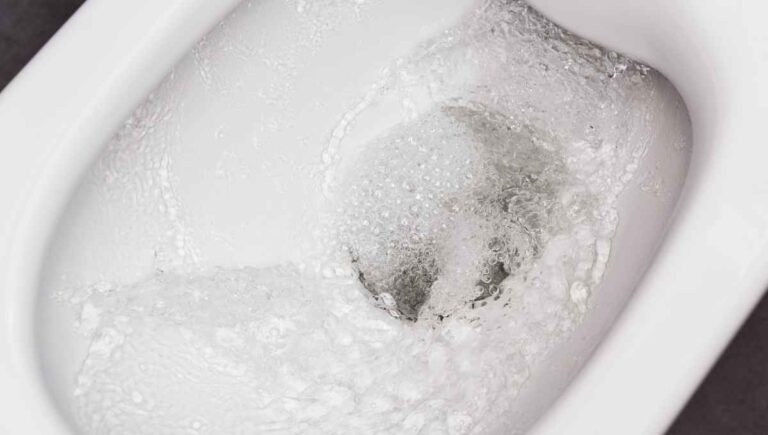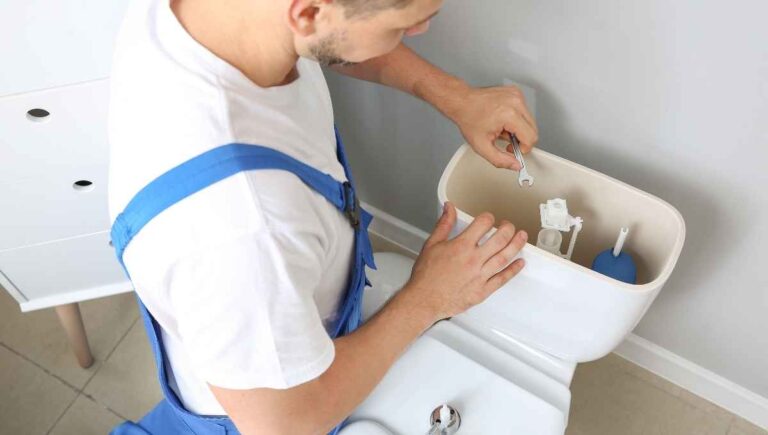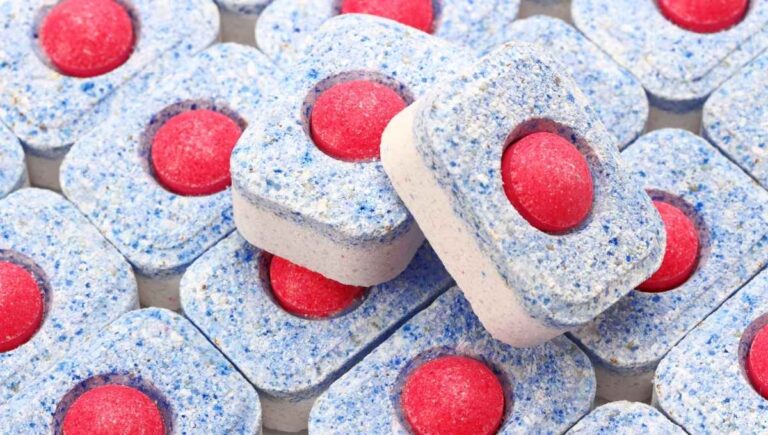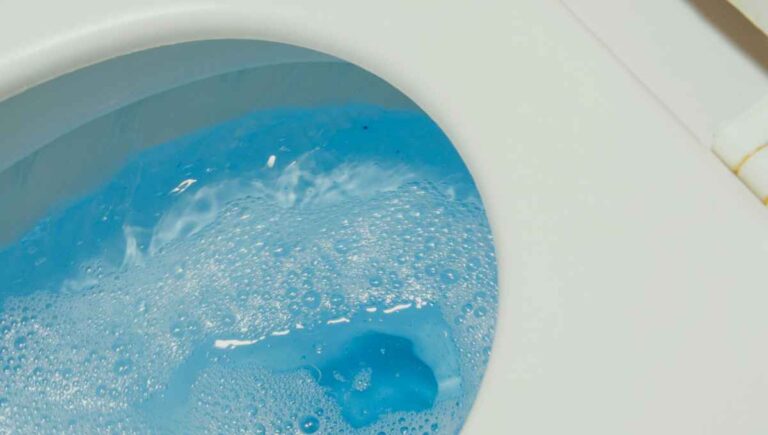Bathroom Walls Sweating All the Time? (Do This to Stop It)
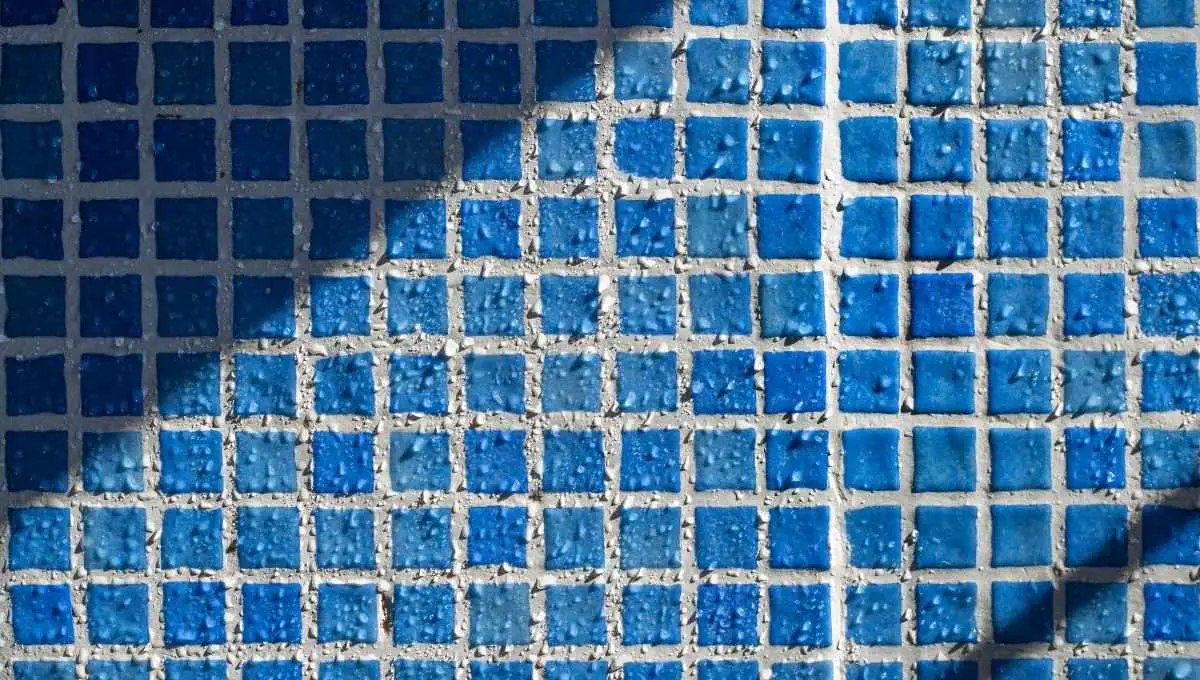
I know it’s gross, but have you ever noticed that your bathroom walls seem to sweat all the time? It’s not just your imagination. Every bathroom wall does this to some degree. But why does this happen, and is there anything you can do about it?
Bathroom walls sweat due to a phenomenon known as condensation. After a bath or shower, moisture in the humid air begins to collect. When this moisture makes contact with your bathroom walls, water droplets begin to form. You can prevent this by making sure your bathroom is properly ventilated.
Understanding why your bathroom walls sweat can help you take steps to prevent it. In this blog post, we’ll discuss the reasons why your bathroom walls sweat and what you can do to stop it. We’ll also provide some tips for keeping your bathroom walls dry and free of mold.
This post contains affiliate links. This means Household Blogger may earn a commission should you make a purchase using any of our links. Please refer to our full affiliate disclosure policy for full details.
Here’s a Quick Pro Tip!
Condensation can be very annoying, and luckily there are many things you can do to prevent it. Some of these include using a dehumidifier or ventilating your bathroom constantly. So, you can fix the problem effectively.
We think you’d love these:
1. New and Improved Exhaust Fan – Ventilate your house with a new and improved fan. You won’t regret getting it!
2. Quiet Small Humidifier – A quiet dehumidifier that can automatically shut off, so you won’t need to worry.
3. Utopia Jumbo Towel – So you can dry your walls effectively.
Why Are my bathroom walls wet?
Before you understand how to get rid of the problem caused by sweaty walls, you have to understand what causes it in the first place.
Luckily, we’ll disclose the ultimate details below!
What Causes My Bathroom Walls to Sweat?
What causes your bathroom to sweat is condensation. It happens after there is a drastic temperature change between your water and your bathroom walls. So, if the walls are extremely cold, but the water you use when showering is hot, then it will condensate.
Condensation happens when the vapor from hot water mixes with the moisture from the air. As a result of this, water drops start forming on your walls. Consequently, it looks as if it was “sweating”.
So, it’s not an unusual occurrence, especially during cold seasons. And, oftentimes, it can also be a big nuisance that needs to be taken care of.
In most cases, it represents a tremendous risk to your property.
Is Condensation on Bathroom Walls Normal?
Condensation on bathroom walls is only normal when it is caused by drastic temperature changes. In this case, both temperatures mix and form the moisture that leads to condensation. But, in some cases, it could mean something else.
Condensation is more common than you think, especially in areas typically prone to cold temperatures.
However, there are instances where condensation implies a malfunction of your exhaust fan. Therefore, you should check it out to make sure everything’s okay.
Why Does It Look Like My Bathroom Walls Are Dripping?
Your bathroom walls look like they’re dripping because of the condensation on your walls. This is due to the mix of your hot water’s steam with the cold temperature. Therefore, they end up looking as if they were dripping or sweating.
In that case, the formed water drops are entirely visible. They can also make your wall color look faded since they will absorb some of the water.
When this happens, you should open a window or use an exhaust fan to help ventilate the space, get rid of the steam, and possibly any odors.
How Do You Clean Sweaty Bathroom Walls?
You can do two things to clean sweaty bathroom walls: dry them with an old cloth or form a solution to clean the marks left by the water droplets formed by condensation. Using one or the other depends on your cleaning objective.
If you are simply looking to eliminate the weird-looking water droplet marks that formed after you showered, drying them with an old cloth or rag will suffice.
But, if you are looking to get rid of harsh stains caused by them, you have to create a home solution to erase them.
So, here are these steps to make this home-made solution that will help you get rid of condensation marks:
- First, you have to find a good and large spray bottle where you can mix the ingredients properly.
- Then, make sure to have ammonia, vinegar, and warm water available.
- You will add one cup of ammonia, two cups of vinegar, and one gallon of warm water to the solution.
- After filling the spray bottle with this solution, mix well.
- Then, apply to the affected areas of your bathroom walls.
- You’ll finish by removing the solution with a sponge and wiping gently for more effectiveness.
This is one good remedy that is believed to work. But, if you don’t want to go over all that work, using a solution of dish soap mixed with warm water will be enough.
Just make sure not to scrub too hard when cleaning, as doing so can actually harm the painting of your walls or tiles.
What Is the Oily Residue on My Bathroom Walls?
The oily-looking residue on your bathroom walls could be produced by surfactants found in the paint of your walls. If your bathroom’s environment does not dry properly, it’s only natural for your bathroom walls to have this residue.
Basically, if the paint doesn’t dry well after condensation happens, it relaxes its surfactants and will cause your walls to look and feel oily.
So, now that you know what provokes it, you don’t have to worry about strange foreign things accumulating on your walls.
You might also enjoy our post on How to Get Rid of Fleas in Your Bathroom
Condensation Issues
So, now that you know what is causing that problem on your walls, it’s time to learn about condensation.
We usually learn about condensation in school when we are talking about the wonders of rain. But there’s no such thing inside a bathroom! So, let’s debunk it below.
How Do I Stop Condensation on Bathroom Walls?
To stop condensation on bathroom walls, you must ensure to control your bathroom’s environment through proper ventilation and temperature management. Fortunately, you can do this in multiple and helpful ways.
You can choose to ventilate your bathroom by leaving your windows open after showering. However, remember that this won’t be very effective during the cold weather season.
Additionally, you can also leave your bathroom door open after bathing for at least 30 minutes. This is more practical since you’re letting the moisture escape.
But, for this to be more useful, the temperature outside your bathroom must be relatively warm.
Moreover, the most obvious way to stop condensation from accumulating on your walls is to use your exhaust fan when showering.
Although, you should turn it on before using your shower or tub and leave it on 30 minutes after finishing.
Yet, keep in mind that you can only turn on your exhaust fan when you plan to use the bathtub or shower. Otherwise, you may risk the safety of your home.
Remember that leaving exhaust fans on for 24 hours or more can cause a terrible fire accident.
On a side note, you can consider using an electrical heating mat for your shower space. This tool works brilliantly to control the temperature of your bathroom before you begin showering.
Just put the underfloor heating mat inside the shower space before you enter to use it.
Allow the heat to change the temperature of the bathroom. After, remove it safely and then proceed to bathe. From that moment until the next day, you won’t suffer from condensation.
How Do You Treat Condensation on Walls?
You can treat condensation on walls by ventilating your bathroom, applying preventative methods before and after showering, or by buying anti-condensation tools that you can use for your bathroom. These should work effectively at treating condensation on walls.
For example, opening a window or your bathroom door will help the air ventilate enough to avoid retaining the moisture that provokes the condensation on your wall.
But, these can only work best on warm days.
Yet, you can get a dehumidifier for your bathroom. This tool works to take the moisture out of the air, so it will work perfectly to prevent the formation of water droplets on your bathroom walls.
According to Healthline, dehumidifiers are good tools that help people with common respiratory issues, such as asthma or allergies.
There are other things you can do to treat condensation on your walls.
For example, you can try using anti-condensation paint for your walls or simply try to induce enough heat inside your bathroom before showering.
To do this, you can try using a heating mat, on your shower or bathtub space, for a considerable number of minutes before you decide to bathe.
It will likely prevent condensation because it will control the room temperature smoothly. So, using hot water won’t affect your bathroom at all.
How Do You Fix Moisture in Bathroom Walls?
The best way to fix moisture in bathroom walls is to elevate the current bathroom temperature. Since condensation forms due to a drastic temperature change, this method is an important way to prevent moisture from forming on your walls.
To control the temperature in your bathroom, simply adjust your thermostat so that it can warm the air enough inside your bathroom space.
The heat will warm the walls sufficiently to allow you to bathe with hot water without affecting them.
But, you can also control your bathroom temperature by using a heating mat, commonly known as underfloor heating, or an electric heated towel.
If you put it inside your bathing space minutes before showering, it’ll control the temperature enough to prevent moisture from forming.
Will a Dehumidifier Stop Condensation on Walls?
A dehumidifier can stop condensation on walls. By default, they work to eliminate the moisture from the air, which is a component that generally helps form condensation. Yet, they’re only able to do so temporarily.
A dehumidifier is a perfect tool for many things, including controlling the condensation on your walls. It can stop condensation from forming inside your bathroom, but only when used.
This means that it won’t stop permanently, just during that specific time.
You might also enjoy our post on How to Get Rid of Slugs in Your Bathroom
How Do You Treat Condensation on Internal Walls?
To treat condensation on internal walls, you have to make efforts to eliminate the moisture from the air by using different tools. But, the best way to approach this situation is by consulting with a professional that can give you better insight.
Different things that can help you prevent condensation include using a dehumidifier and adjusting your thermostat to raise the temperature of your house.
But, you have to be careful with this type of condensation since it could imply many things.
For example, condensation in your internal walls can imply the existence of structural damages within your property.
When this happens, your interior walls likely have rising dampness. Usually, external condensation forms this dampness.
So, without condensation, there is no rising damp. And in these cases, a professional will give you better information that can help you determine the proper way to proceed.
Unfortunately, some instances may require you to abandon your property to fix these issues.
Strange Colors on the Wall
Now that you know about condensation and what can you do about it, you have to learn about different types of condensation. So, let’s learn about it now!
What Does Condensation Look Like on Walls?
In its early stages, condensation looks like water droplets that just sit idly on your walls. But, if the condensation is advanced, it can look like dampness and mold accumulation on your bathroom walls. Therefore, it’s something that needs immediate treatment.
So, the thing is that condensation will look like water drops that just sit on your wall but suddenly start drying out when the temperature normalizes.
But, if this is a common occurrence in your household, it can be accompanied by mold.
Since mold loves humid environments, it’s no surprise that condensation is one of the things that provoke it.
So, it’s imperative to treat condensation effectively to avoid having it in your bathroom since it could cause many issues.
Yet, there are other instances where condensation has an odd color, such as brown or yellow. In these cases, elements like fungi or surfactants may be involved and need quick treatment.
What Causes Yellow Drips on Bathroom Walls?
The thing that causes yellow drips on bathroom walls is the accumulation of fungi. Fungi can attack walls and ceramic tiles, so when it happens, it will cause your walls to “drip” this yellow-looking and unpleasant color.
When mineral buildup accumulates on your bathroom walls, it can create these fungi. You’ll notice it immediately after touching your wall’s surface because of how disgustingly sticky it becomes.
So, because of it, your bathroom wall will start dripping yellow.
Why Do My Bathroom Walls Sweat Brown?
Your bathroom walls are sweating brown because of the paint used on them. Usually, this phenomenon happens with latex, water-based paint. When your walls sweat brown, this means that the surfactants from this paint are released.
Condensation will cause this paint to drip. This dripping results in this brown, oily-looking residue forming on your bathroom walls. And, their surfactants cause this.
Luckily, you can substitute this type of painting with this anti-condensation painting.
Does Paint Stop Bathroom Condensation?
Paint does not stop bathroom condensation, especially if it’s a regular water-based paint. But, there is an anti-condensation paint that you can use to help keep it at bay. In short, it does not stop it. It prevents it.
Regular wall paint can’t stop your bathroom from suffering condensation. However, using anti-condensation paint can help you prevent moisture from accumulating in your bathroom.
This paint traps this moisture to prevent condensation.
So, even though paint can’t stop it from happening, you can still use this anti-condensation paint to prevent it. Hopefully, you’ll be able to do so quickly.
How to Ventilate to Reduce Humidity
Condensation can happen in any bathroom, and one way to prevent it is through ventilation. But how to do it correctly? Let’s discover it below.
How Do You Ventilate a Bathroom?
To ventilate a bathroom, try to keep the air inside your bathroom flowing constantly. You can do this by using your exhaust fan or keeping any door or window open to allow the bathroom receive fresh air continuously.
Keeping your door open while at the same time you keep your window open will allow your bathroom to have a refreshed environment.
Doing this helps keep your bathroom moist-free, reducing the chances of condensation in the future. Yet, it’s more convenient in warm weather.
Should I Insulate My Bathroom Walls?
Whether or not you should insulate your bathroom walls depends on your preference, but we highly suggest it. Insulating your bathroom walls won’t only keep it at a comfortable room temperature, but it will also prevent mold growth.
Bathroom wall insulation helps prevent mold growth because it keeps the bathroom at a stable temperature.
Therefore, some local regulations even have it as a building code requirement. So, you should check them out.
How Do You Dry Out Damp Walls?
To dry out damp walls, try to open your windows and doors to keep the airflow going. Use fans to accelerate the process, and consider getting a dehumidifier to help your walls avoid retaining moisture that can be problematic in the long run.
Usually, damp walls happen as a result of devastating water damage. So, opening doors and windows will help them dry quicker. But, this isn’t enough.
You have to try using methods that increase the heat inside your home.
Using fans, dehumidifiers, and adjusting your thermostat to increase the temperature can help you resolve this matter effectively.
Remember to watch out for mold issues. Identify objects that can get mold and remove them from the area.
Don’t hesitate to consult with a professional if you suspect that your plumbing is responsible for your damp walls.
It will help you get rid of the matter quickly, so you won’t have to deal with these emergencies further.
Does Opening Windows Reduce Damp Walls?
Opening windows inside your bathroom won’t reduce damp walls. This method can only be used when you are trying to prevent damp walls or you want to accelerate their drying process. But, in terms of reducing or eliminating the issue, it won’t.
Heavily damp walls can indicate the existence of plumbing issues or property damage. So, opening the windows won’t do much, although it can be helpful in many circumstances.
We recommend that you consult a professional for more details.
How Do You Remove Humidity From Walls?
The best way to remove humidity from your walls is by using a dehumidifier. This machine is excellent at controlling the moisture around your home’s environment, which will reduce humidity and can even help you prevent condensation.
Since dehumidifiers reduce humidity in any space where you put them, they are excellent at eliminating the chances of getting mold.
Also, you should invest in wall insulation to reduce the chances of accumulating humidity. That way, you won’t have to face this issue again.
You might also enjoy our post on Can Bathroom Windows Be Clear?
Related Questions
How Do You Tell if It’s Rising Damp or Condensation?
To tell if it’s rising damp or condensation, you must know the key differences that distinguish them. Condensation will look like water drops and mold, while rising damp will look like wetness on the ground floors.
First and foremost, you have to understand what condensation is. Condensation is what happens when hot air comes in contact with cold air.
It usually happens in humid places, and the steam from your cooking or hot shower can cause it.
Condensation is seen as water drops forming on your walls and is usually followed by patches of black mold, which must undergo treatment to avoid serious health issues.
But, if the issue with condensation escalates, dampness appears. This means that your walls are wet inside and should be treated before it worsens.
While condensation can be resolved without much problem at its early stages, dampness is harder to erase.
When we talk about rising dampness, we talk about the accumulation of water due to condensation that usually happens on ground-level floors.
So, to tell one from the other, you have to check for each one of the signs mentioned above that can help you identify it.
Rising dampness is a more serious issue, so in this matter, you should consult a professional immediately.
How Do You Tell the Difference Between Penetrating Damp and Condensation?
You can tell the difference between penetrating damp and condensation by looking at the issue your wall currently presents. While condensation forms water drops accompanied by black mold, penetrating damp gathers external water into your walls.
Penetrating damp happens after your walls accumulate water from external sources.
So, it’s not going to be as visible as condensation since condensation can be identified by the black mold marks it leaves on your walls.
Just like rising damp, penetrating damp can represent a bigger issue that needs to be resolved.
Outside water begins to make its way through the wall, so it can damage your property’s structure. So, it’s best to call an expert to help you.
How Do You Tell if It’s a Leak or Condensation?
To tell whether it’s a leak or condensation, you have to learn to identify them. Leaks don’t occur in the same areas where condensation does, so it’s easier to distinguish them. Moreover, it’s common to find leakages on the roofs.
Usually, leaking happens when there are problems with plumbing or after the roof has suffered severe damage and water has made its way through there.
It’ll appear as a solid patch on the roof or any other place where condensation is less likely to appear.
On a side note, condensation simply looks like water stains, and it’s more of an internal issue rather than an external issue.
It happens when hot steam mixes with the cold temperature of your wall’s surface. Therefore, it forms water drops, and it’s usually followed by mold.
Resolving a leakage issue is more complicated than resolving condensation.
You can resolve condensation by drying the walls with an old cloth or by adjusting your home’s temperature to avoid it from happening again. For a leak, it’s best to call a plumber or contractor.
Final Thoughts
Condensation can lead to dangerous situations in your home since things can escalate and cause your walls to have dampness, which can be detrimental to your property.
Your walls keep sweating because of that issue, and luckily, there are ways to identify and eliminate them.
However, if it has a brown or oily texture, it may be the surfactants of your paint getting out.
You can use dehumidifiers to decrease the chances of condensation from happening again. And, they’ve proven to be quite helpful for other issues.
Hopefully, you’ll be able to resolve the issues with your walls effectively.






